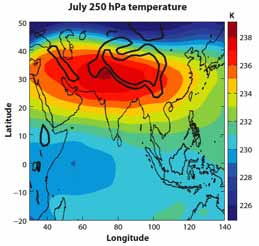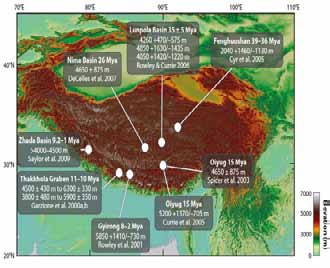 |

|
| Molnar Home | Research Projects | Publications |
| RESEARCH GROUPS @ CIRES > |
Figure 1: (top) Upper-tropospheric temperature (250 hPa) over Asia in July; the maximum overlies northern India and Pakistan, not the Tibetan Plateau. Figure 2: (bottom) The moist entropy in July on a terrain-following model level within 50 hPa (about 500 m) of the surface. All quantities are means for 1979–2002 from the ERA-40 reanalysis dataset. |
Northern Tibet and Hydrological CycleTibet East Asian Climate: Clues to the Hydrological Cycle
Collaborators
Suggestions that the rise of the Tibetan Plateau affected climate not only over eastern Asia, but also globally, point to northern Tibet as the most likely part of the plateau to have risen in the past ~10-20 million years. Hence its growth in that period is a focus of this study. We seek to determine when the region rose to its present elevation and what processes occurred in the crust and upper mantle that are responsible for the present-day elevations.
To bridge the gap between geologic processes occurring on million-year time scales and those measured reliably only since the past century, studies of paleoclimate at the intermediate time scale of thousands to hundreds of thousands of years: reconstructions of paleo-precipitation on the loess plateau and analyses of δ18O in speleothems from Tibet and eastern China. A recent review by a couple of us (Molnar, Boos, and Battisti, 2010) summarizes some of the controversies and opportunities. ReferencesDayem, K. E., P. Molnar, D. S. Battisti, and G. H. Roe (2010), Lessons learned from oxygen isotopes in modern precipitation applied to interpretation of speleothem records of paleoclimate from eastern Asia, Earth Planet. Sci. Lett., 295, 219-230. Molnar, P., W. R. Boos, and D. S. Battisti (2010), Orographic controls on climate and paleoclimate of Asia: Thermal and mechanical roles for the Tibetan Plateau, Annual Reviews of Earth & Planetary Science, 38, 77-102. |

 Supported by NSF’s Continental Dynamics Project
Supported by NSF’s Continental Dynamics Project The most obvious hypothesized manifestations of that growth concern precipitation, and the geologic quantities that depend on it (stable isotopes of hydrogen δD and oxygen δ18O). Thus, a second part of our study address how atmospheric circulation perturbed by Tibet affects the hydrological cycle, and in particular the values of δD and oxygen δ18O in both modern precipitation and in geologic materials that trap these isotopes and offer methods for determining paleo- altitudes.
The most obvious hypothesized manifestations of that growth concern precipitation, and the geologic quantities that depend on it (stable isotopes of hydrogen δD and oxygen δ18O). Thus, a second part of our study address how atmospheric circulation perturbed by Tibet affects the hydrological cycle, and in particular the values of δD and oxygen δ18O in both modern precipitation and in geologic materials that trap these isotopes and offer methods for determining paleo- altitudes.